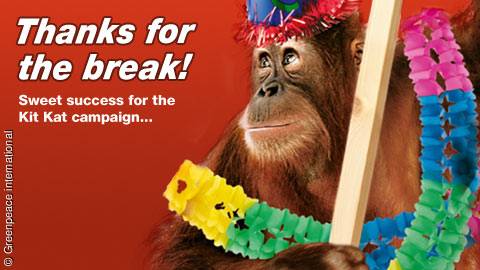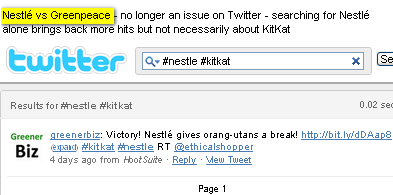Nestle Social Media: Have A Break, Have A Kit Kat
Nestle Social Media

The environmental group Greenpeace launched a social media campaign directly against Nestle’s product KitKat on March 17th 2010. Greenpeace released a YouTube video which parodied the brands “Have a break, have a KitKat” strapline. In the video, Greenpeace highlighted the unsustainable destruction of forests which occurred in order to produce palm oil. Palm oil is a widely used ingredient in the Swiss manufacturer’s products, including KitKat.
The video was the result of Greenpeace’s discovery that Nestle was sourcing their palm oil from the Indonesian company Sinar Mas, which used unsustainable sources to obtain the oil. In their initial defence Nestle claimed they were responsible for only 0.7% of all global palm oil consumption. The video featured a bored office working taking a bite from a KitKat which transformed into the bloody finger of an orang-utan and featured the caption “Give the orang-utan a break”. The YouTube video can still be viewed in its entirety by clicking here.
Nestle’s initial response was to demand the video was removed from YouTube on grounds of copyright issues. However, this move backfired, a backlash of viral criticism ensued. Facebook users were particularly vocal in complaining about threats to remove images from their pages, where the KitKat logo had been changed to “Killer”. The disgruntlement soon gained a momentum in the world wide press.
The Greenpeace video was removed from YouTube, however Greenpeace merely posted the video on Vimeo instead. Within a matter of hours the Vimeo video received over 78,500 views. The video was reposted on YouTube on March 21st 2010. The challenge which faced the Nestle team was twofold. Primarily they had to limit the damage the campaign was causing to their brand and secondly the chocolate manufacturer needed to address the palm oil sourcing issue.
Opposed to attempting to limit the social media conversation, Nestle adopted an alternative approach. The company severed all dealings with Sinar Mas and invited members of Greenpeace to meetings where they provided all the information surrounding their palm oil supply process. Nestle then began to look for credible companies who could provide their palm oil on a long term basis. By May 2010 this had resulted in Nestle’s membership to the Roundtable for Sustainable Palm Oil, a group which aims to eliminate the unsustainable production of palm oil.
Moving forward, Nestle created the post of “Global Head of Digital and Social Media”, to which they employed Pete Blackshaw. By early 2011, Blackshaw had created a “digital acceleration team”. The Nestle social media team’s objective was to gauge social media based public sentiment to Nestle 24 hours a day. If the team noticed a fall in sentiment or foresaw issues, the communications element of the team launches direct engagement with the involved parties whether it be individual users or campaigners such as Greenpeace.
When asked about how he gauged the Nestle social media success Blackshaw responded, “Perhaps the best measure of success is the overwhelming sound of silence.” Nestle addressed the issue of palm oil sourcing by setting the goal of using completely sustainable palm oil sources by 2015.
Nestle’s success in dealing with Greenpeace’s social media criticism was due to their willingness to engage directly with their critics and address their concerns and grievances directly. It is equally as important to note that the targeted Nestle social media campaign demonstrates quite clearly the negative backlash which a company can receive as a result of attempts to try and squash the online discussion. Due to this it is far better to address the complaints directly then try to dismiss them. The targeted Nestle social media campaign resulted in a better procedure for the Kit Kat product and the brand as a whole for taking responsibility and resolving the situation in real life.

